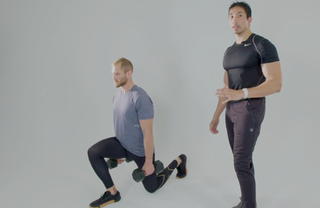The lunge is a core training staple that can help to build strength and size in your legs, but are you sure you’re even doing the exercise correctly?
For this gold standard leg move, you shouldn’t settle for anything other than perfect form—especially because it’s such a simple, essential movement that should serve as one of the centerpieces of your training plan. Let Men’s Health fitness director Ebenezer Samuel, C.S.C.S. and associate fitness editor Brett Williams guide you through the move’s subtleties, saving you from the bad habits that are keeping you from unlocking your fitness potential.
Before you drop down and get lunging, take note that it’s extremely important to pay attention the movement here. Smacking your knee down on the ground won’t just leave you scraped and bloody—you want to be much more deliberate in your steps.

Men’s Health
Glutes On
Eb says: When you step forward turn your glute on, so your knee shifts slightly outward. People often have a habit of letting their knee shift toward their midline, and that’s the last thing you want. The same way you push your knees out when squatting, you want to create that same motion when you lunge to protect the health of your knee in the long run.
Chest Up
Eb says: Don’t let your chest fall, and don’t let your upper body be a momentum-generator in the lunge. This is a leg move, and you want it to be driven by your legs, not some attempt at rocking your upper body or your shoulders, or hinging forward to get up.
Think about keeping a tight core, and keeping your shoulder blades down and in in a standard lunge; maintain that rigidity as you’re lowering and standing up.
No Back Knee Slam
Eb says: There’s a dynamic quality to the lunge, but this is still a move about control. Exhibit that and control your body as you lower into the lunge, making sure your back knee doesn’t hit the ground or slam into it. You should be in enough control as you lower down that your back knee stops an inch from the ground.
Work in Reverse
Eb says: If you’re not feeling comfortable with the forward lunge, shift to the reverse lunge, which, in many ways, is actually superior to the forward lunge. It’s going to alleviate a lot of stress on that front knee, and it’ll force you to be spatially aware as you step back.
And the best part about the forward lunge (and the reason I love it so much): When you stand up from it, it gives you more natural hip extension, mirroring an action that we need more of in real life.
Once you’re comfortable with the movement, try out these lunge variations.
Source: Read Full Article
